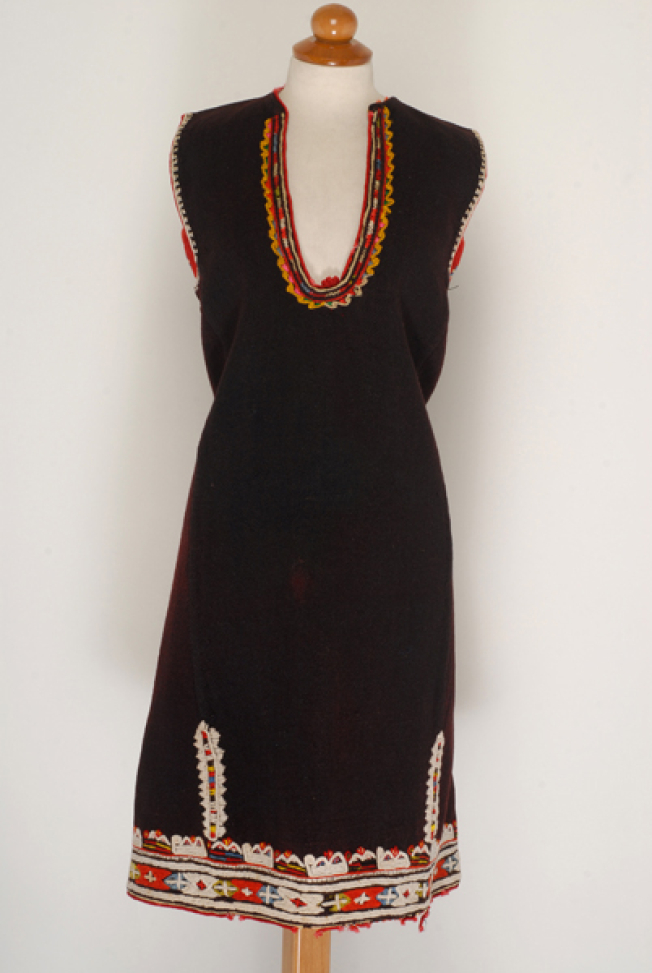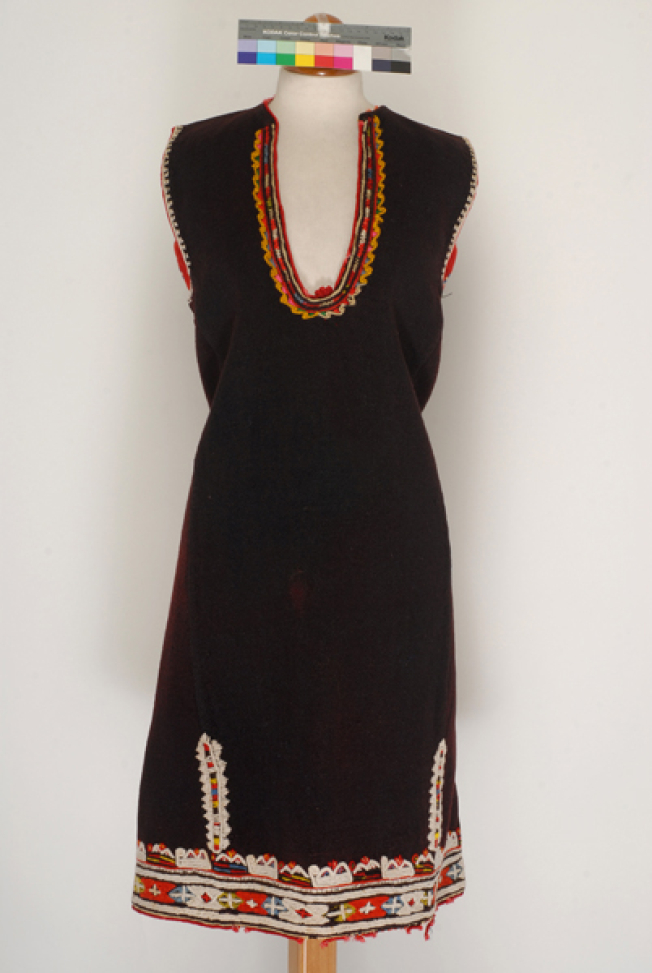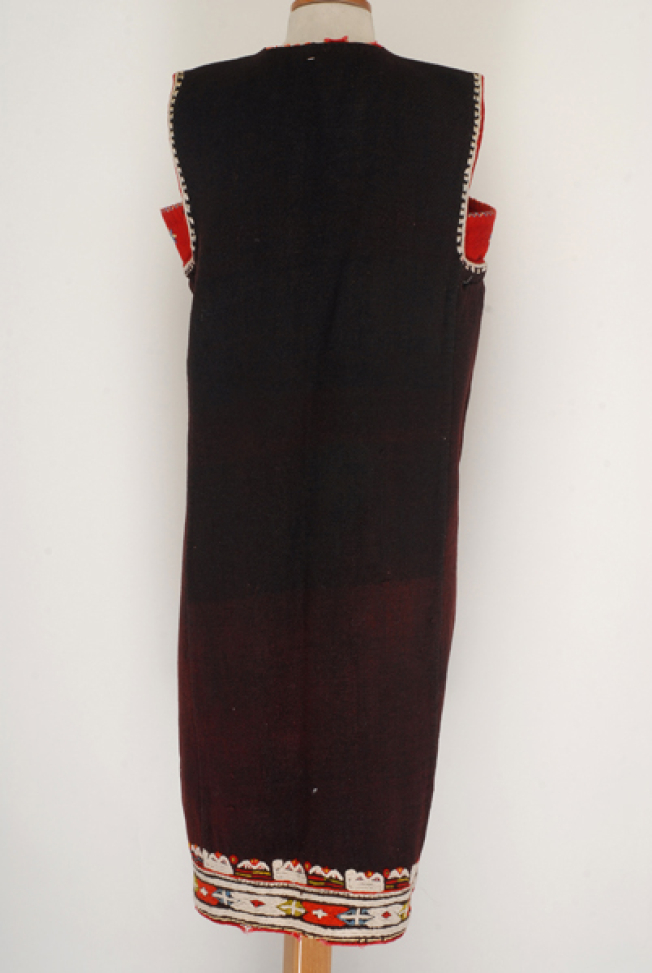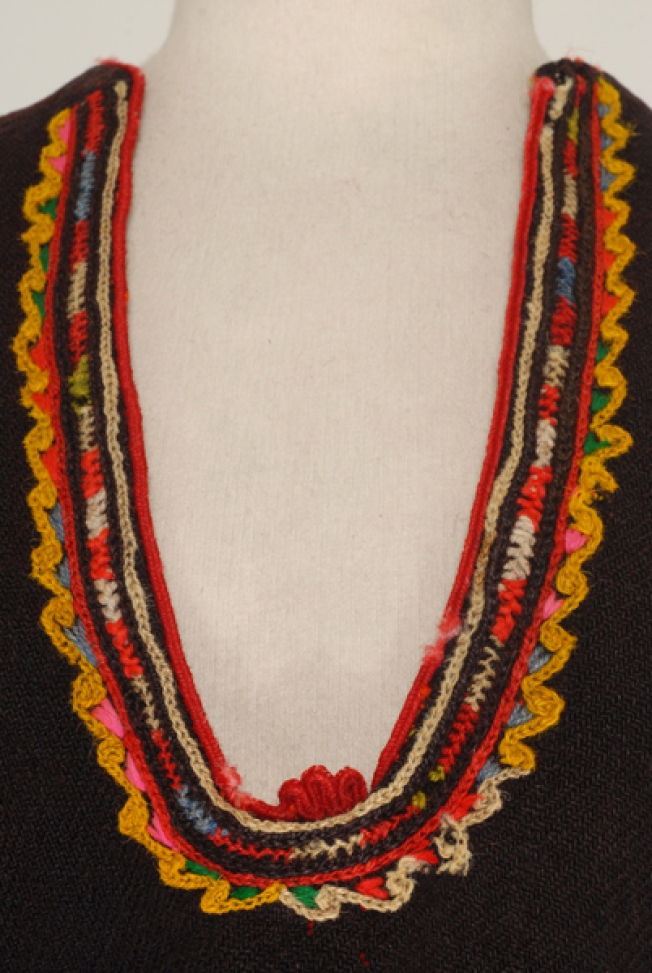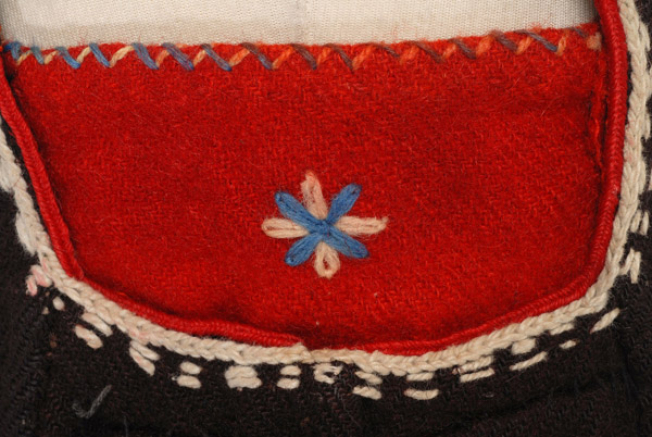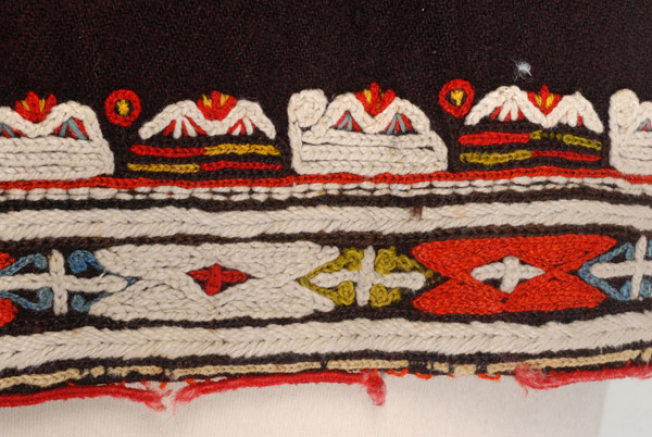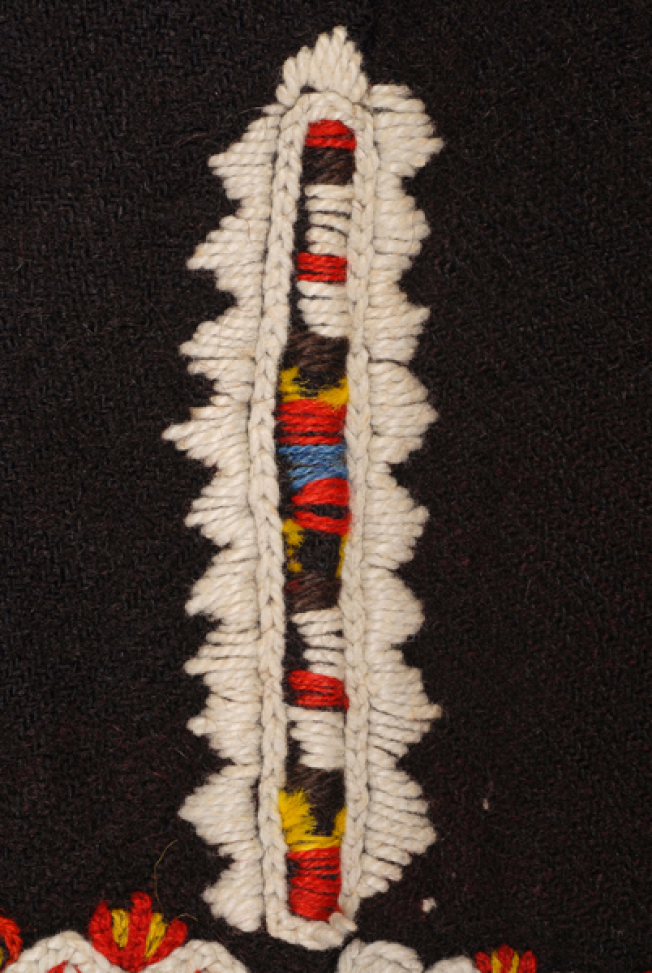foustani (dress)
14101
Foustan gourgiste dress of the middle-aged married woman
Foustan gourgiste dress of the middle-aged married woman
Detail of the decoration at the traile, plastron: gaitani, vitsa, alatza fourkeza and tieli thritour
Detail of the decoration at the kavadoura: blossom at the additional piece and gaitani, vitsa and miligona at the joint with the dress.
Object Identity
Object ID Number
14101
Object name
foustani (dress)
Other / Local name
foustani gkourgkiste
Style
peasant
Production date range
beginning of 20th century
Part of outfit
No
Physical Description
Description
Φουστάν γκουρκίστε, δηλαδή "φουστάνι ελληνικό". Πρόκειται για μαύρο, αμάνικο φουστάνι που φορούν οι παντρεμένες γύρω στα 40. Είναι καμωμένο από αδίμτο (δίμιτο) σαγιάκι (μαλλί της νεροτριβής), από τις ίδιες τις γυναίκες στον αργαλειό. Ύστερα γινόταν το ντουλάπιασμα, το κέντημα στο χέρι και τέλος η βαφή. Τα μαύρα σαν αυτό φουστάνια βάφονταν με σατζίκιμπριτ (μαυρόχρωμα) και κελεμπέκι (τα φύλλα της καλαθιάς). Τα βαμβακερά νήματα του κεντήματος κατά τη βαφή δεν "έπιαναν" χρώμα. Το φουστάν αποτελείται από ένα μονοκόμματο φύλλο υφάσματος μπρος - πίσω και στο πλάι φαρδαίνει με την προσθήκη τεσσάρων λοξών φύλλων, που ονομάζονται κλίντα, (δύο σε κάθε πλευρά) από το άνοιγμα της μασχάλης, καβαδούρα, και κάτω. Εντύπωση προκαλούν τα δύο επιπλέον τμήματα (από κόκκινο σαγιάκι) στο άνοιγμα της καβαδούρας.
Εσωτερικά, το άνοιγμα του αυχένα είναι ρελιασμένο με καφέ, υφαντό βαμβακερό κομμάτι υφάσματος. Για τη διακόσμηση πρώτα στρίφωνουν τα ανοίγματα. Η διαδικασία του κεντήματος χωρίζεται σε δύο στάδια. Το πρώτο, με το βάρδε ή κιτρίνισμα, είναι η εκτέλεση της κεντητής διακόσμησης του ποδόγυρου με χρωματιστά νήματα και βελονιά αλυσίδα. Το δεύτερο, με το μπάρδε ή άσπρισμα, είναι η εκτέλεση της διακόσμησης με λευκό, ελαφρά κλωσμένο βαμβάκι, με βελονιά θηλειά. Η διακόσμηση από κάτω προς τα πάνω είναι η εξής: κόκκινο γκαϊτάνι, κίτρινα και καφέ βίτσα (σειρές καμωμένες με βελονιά αλυσίδα από μάλλινα νήματα), λευκά φούρκεζα (κλαδί με διχαλωτή απόληξη), οριζόντια ζώνη με καρούλε (χρωματιστοί ρόμβοι με λευκό σταυρό στη μέση) και κλίτσε (τα υπόλοιπα μοτίβα της ζώνης), λευκά φούρκεζα, λευκή μιλιγκόνα (διακόσμηση με βελονιά γαζί ή πατητή). Στην πιο ψηλή σειρά, κεντητά σχηματοποιημένα μοτίβα, τα πελιστέρε. Όλες αυτές οι ζώνες διακόσμησης χωρίζονται με πολύχρωμα βίτσα. Πάνω από την οριζόντια διακόσμηση του ποδόγυρου, οι μπροστινές ραφές διακοσμούνται με δύο κατακόρυφα σχηματοποιημένα μοτίβα. Η διακόσμηση στην τραϊλέ, τραχηλιά, γίνεται με κόκκινο γκαϊτάνι, βίτσα, αλατζά φούρκεζα (;) και τιέλι θρίτουρ, γαίτάνι κλειστό, ζιγκ-ζαγκ. Τέλος, γίνεται η διακόσμηση στην καβαδούρα με κόκκινο γκαϊτάνι, βίτσα και μιλιγκόνα. Τα κόκκινα τμήματα φέρουν από ένα κεντητό ανθάκι, καμωμένο με άσπρο και γαλάζιο μάλλινο νήμα.
Decoration & Patterns
Decoration
geometric decoration
Decorative patterns / subjects
fourkeza, vitsa, klitse karoule, miligkona
Decoration
religious motifs
Decorative patterns / subjects
small crosses
Decoration
stylized decoration
Decorative patterns / subjects
pelistere
Decoration
vegetal decoration
Decorative patterns / subjects
-
Height
1.080
Width
0.360
Production
Maker / Designer / Brand
women themselves
Production date range
beginning of 20th century
Production place (Country | Geographic Area | Prefecture & Region)
-
Eastern Thrace (Mega Zaloufi)
Material
cotton
cotton thread
fullen wool fabric
wool cordon
wool thread
Techniques
applique
handwoven fabric
handwoven fabric,
dimity fabric
handwoven fabric,
nerotrivi (fulling-tub), ntoulapia
traced design embroidery,
chain
traced design embroidery,
daring or bouble running
traced design embroidery,
loop
Use
Population / Cultural / Ethnic group
refugees
User
woman
Age
middle-aged woman
Status
married woman
Occasion
festive
Purpose
It is worn by married women in their forties
Date range
beginning of 20th century
Place of use (Country | Geographic Area | Prefecture & Region)
-
Eastern Thrace (Mega Zaloufi)
Acquisition
Acquisition method
Untraced Find
Documentation
Research bibliographic references
Image license
Use the file or the thumbnail of the image according to the license:
CC BY-NC-ND 4.0
Attribution-NonCommercial-NoDerivatives





